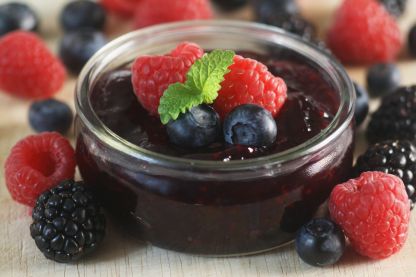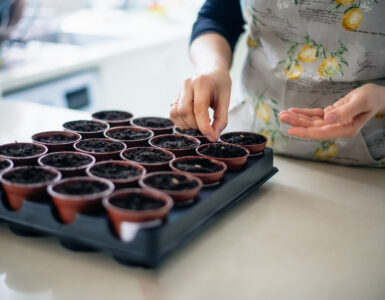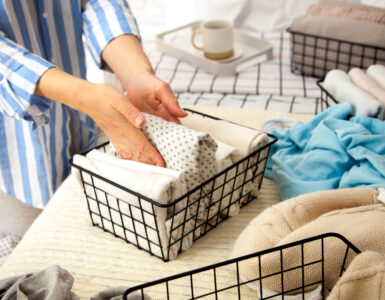Consumer educator, Teresa Hunsaker says homemade jams and jellies are the perfect way to preserve the sweet taste of summer all year long.
Oh…the sweet tastes of spring and summer produce… strawberries, raspberries, apricots, rhubarb, are all wonderful to look forward to in abundance. When all these wonderful things are in season, it’s time to make homemade jam or jelly. And, it’s a great place to start honing your canning skills too.
A true jam or jelly is made with fruit and its natural pectin, sugar, and acid (either from the fruit or added). It is also a true jam or jelly if pectin is added to the fruit to reduce the cooking time, so most of us will make our jams and jellies with pectin added.
There are many other kinds of sweet spreads, including freezer jams/jellies that people like to make too. Or there are fruit spreads that use gelatin to thicken, or instant starches, or even flavored “Jello”, but a true jam is cooked with fruit, pectin, sugar, and acid, and they can be kept on the shelf, not the fridge or freezer, like the others.
Here is more information to help us:
Jam – Crushed or chopped fruit cooked with sugar. Sweet and firm, but spreadable.
Jelly – Fruit juice cooked with sugar. Firm and translucent.
Conserve—a mixture of fruit, nuts, raisins, coconut that is also gelled.
What makes a jam or a jelly?
Fruit – provides the color and flavor. Use fruit at the just ripe stage for optimal color and flavor.
Pectin -is a natural substance that causes fruit to gel. It is extracted and sold commercially as a
powder or a liquid. The amount of pectin found naturally in fruit varies between types and ripeness. Fruits that are just under ripe contain the largest amounts of pectin.
Store pectin in a cool, dry place. It should be used by the expiration date and not stored for use the next year. Note: Different brands of pectin can perform differently when substituted in another brand’s recipe.
It is suggested to use a recipe formulated by the brand pectin you are using for the jam/jelly you want to make, OR, take the risk of having a product that may not set.
Acid -helps form the gel and adds flavor. Lemon juice or citric acid can be used in low-acid fruits.
Sugar – Works with the pectin and acid to gel the product. It must be used in the correct proportion as
indicated in the recipe. It is also a preservative to prevent microorganism growth.
Materials needed:
Large, 8 – 10 quart saucepan
Boiling water bath
Ladle
Jars: wash in hot, soapy water and rinse. It is not necessary to sterilize in boiling water for 10 minutes, but a good idea. Keep in hot water until needed.
Lids: wash in hot, soapy water and rinse. Prepare according to manufacturer directions.
If making jelly – jelly bag or 4 layers of cheesecloth to strain fruit juice
If making jam – skimmer or slotted spoon to remove foam
Optional – food scale
Candy thermometer
Spice bag
Gelling Test
Dip a cool, metal spoon into the boiling jelly and lift out a spoonful of the product.
Tip the spoon so the product will drop off into the pan.
If the drops are light and syrupy, keep boiling.
Stop boiling when the product “sheets” off the spoon.
NOTE: some people actually like to use a thermometer when making jams and jellies. The gelling point for a jam/jelly is 8°F above the boiling point for your elevation. This starts at 220°F and decreases 2°F for everything 1000 feet you are above sea level.
| Elevation | Boiling Point |
Gelling Point |
| 0 – 1000 feet |
212°F | 220°F |
| 1001 – 2000 feet |
210°F | 218°F |
| 2001 – 3000 feet |
208°F | 216°F |
| 3001 – 4000 feet |
206°F | 214°F |
| 4001 – 5000 feet |
204°F | 212°F |
ADDITIONAL INFORMATION
√ Do not double recipes—double size mixtures do not cook in the same manner and may not gel.
√ Weeping jam/jelly is caused by insufficient acid.
√ Recipes with pectin added (either liquid or powder) are not cooked to the gelling point as indicated in the chart above.
√ If wanting to replace sugar with honey or corn syrup find and use only tested recipes for this replacement as adjusting the recipe yourself will likely result in a poor gel.
√ If your jelly is cloudy it may be due to air bubbles from letting the jelly mixture stand too long before pouring into jars, or poor straining, or fruit not ripe enough.
√ Mold growth may occur when there is an imperfect seal or too much air space, or on products that are not a true jam/jelly.
√ Crystals in jelly are typically caused by over cooking the jam/jelly or seed sugar crystals not dissolved on edge of pan, spoon handle, etc. when pouring out of pan into jars.
√ For a jam or jelly “remake” when it does not gel, go to http://www.extension.usu.edu/weber
RECIPES
Blueberry-Spice Jam – makes about 5 half-pint jars
2 ½ pints ripe blueberries
1 T lemon juice
½ tsp ground nutmeg or cinnamon
5 ½ cups sugar
¾ cup water
1 box (1 ¾ oz) powdered pectin
Wash and thoroughly crush blueberries, one layer at a time, in a saucepan. Add lemon juice, spice, and water. Stir in pectin and bring to a full rolling boil over high heat, stirring frequently. Add the sugar and return to a full rolling boil. Boil hard for 1 minute, stirring constantly. Remove from heat, quickly skim off foam, and fill sterile jars, leaving ¼ inch headspace. Adjust lids and process for 10 minutes.
Source: So Easy to Preserve
No sugar added Strawberry Jam – makes about 6 half-pint jars
2 quarts strawberries
1 cup water
1 pkg no sugar needed powdered pectin
Wash strawberries; drain. Stem and crush strawberries; measure 5 cups. Combine strawberries and remaining ingredients in a large saucepot, stirring to dissolve pectin. Bring to a boil, stirring constantly. Add sweetener according to pectin package guidelines, if desired. Boil 1 minute, stirring constantly. If gel starts to form before 1 minute boil is complete, remove from heat. Ladle hot jam into hot jars, leaving 1/4 -inch headspace. Remove air bubbles. Adjust two-piece caps. Process 10 minutes in a boiling-water canner.
Source: Ball Blue Book
Apple Jelly with Gelatin – makes about 2 half-pint jars (refrigerated storage)
4 tsp unflavored gelatin
2 cups unsweetened apple juice
2 T liquid sweetener
1 ½ T lemon juice
Food coloring (optional)
Sterilize jars. Soften gelatin in ½ cup of apple juice. Bring remaining 1 ½ cups juice to a boil, remove from heat. Add softened gelatin, stirring to dissolve. Add liquid sweetener, lemon juice and coloring. Bring to a full, rolling boil. Pour into sterilized jars. Seal, cool, and store in the refrigerator.
Source: So Easy to Preserve
Orange Jelly from frozen concentrated Juice – makes about 6 half-pint jars
12 oz concentrated orange juice, thawed
2 ½ cups water
4 ½ cups sugar
1 box powdered pectin
Sterilize canning jars. Measure sugar and set aside. Mix juice and water in a saucepot. Stir in powdered pectin. Bring to a full boil over high heat, stirring constantly. At once stir in sugar. Stir and bring to a full rolling boil that cannot be stirred down. Boil hard for 1 minute, stirring constantly. Remove from heat; quickly skim off foam. Pour jelling immediately into hot canning jars, leaving 1/4 -inch headspace. Wipe jar rims and adjust lids. Process 5 minutes in a boiling water bath.
Source: So Easy to Preserve
Blueberry Jelly with liquid pectin – makes about 8 half-pint jars
4 cups blueberry juice (about 2 quarts blueberries)
7 ½ cups sugar
2 pouches liquid pectin
To prepare juice – Sort and wash ripe blueberries. Thoroughly crush one layer at a time. Place in a saucepan, bring to boil, cover and simmer for 5 minutes, stirring occasionally. Pour into a damp jelly bag and suspend the bag to drain the juice.
To make jelly – Sterilize canning jars. Measure juice into a large saucepot. Stir in the sugar. Place on high heat; stir constantly and bring to a full rolling boil that cannot be stirred down. Add liquid pectin and heat again to a full rolling boil. Boil hard for 1 minute. Remove from heat; quickly skim off foam. Pour jelly immediately into hot canning jars, leaving ¼-inch headspace. Wipe jar rims and adjust lids. Process 5 minutes in a boiling water bath.
Lavender Jelly
2-1/4 cups bottled apple juice (the clearest you can find)
1 cup lavender flowers
3-1/2 cups granulated sugar
1/2 (4 ounce) bottle liquid pectin
Place apple juice and lavender in a saucepan and bring to a boil. Cover and remove from the heat. Let stand for 15 minutes, then strain.
Return 2 cups of this juice to the heat. Add the sugar and stirring constantly, bring to a full boil. Stir in the liquid pectin and bring to a rolling boil for 1 minute, stirring constantly.
Remove from the heat, skim off the foam, and pour into jelly glasses with a sprig of jelly in each glass and seal. Process for 5 minutes in a boiling water bath. Source: The Forgotten Art of Flower Cookery.
Ginger Honey Rhubarb Jam Source: www.divinerecipes.com
1 lemon
2 cups chopped rhubarb, fresh or frozen
1 large apple, peeled, cored & finely chopped
1/2 cup water
1-1/2 cups sugar
1 cup liquid honey
1-1/2 tablespoons candied ginger, finely chopped (or crystallized)
Remove thin outer rind from lemon with a veggie peeler& cut into fine strips with scissors or sharp knife- or use a zester. Place in a medium stainless steel or enamel saucepan. Squeeze & reserve 1 TBS of juice from lemon. Add rhubarb, apple& water to saucepan. Bring to a boil over high heat. Cover, reduce heat & boil gently for 15 minutes or until fruit is tender. Add sugar, honey, ginger& lemon juice.
Return to a boil& boil rapidly, uncovered, stirring frequently, until mixture forms a gel (about 10 minutes). Remove from heat. Ladle into hot, sterile jars and process in a water bath for 10 minutes.
Remove from bath, let jars cool, label & store in a cool place.
Resources:
National Center for Home Food Preservation
www.uga.edu/nchfp
USDA Complete Guide to Home Canning
Ball Blue Book
www.divinerecipes.com
If you have any questions, contact Teresa Hunsaker at the Family and Consumer Science Education Department at the Weber County USU Extension office at (801) 399-8203 or online at www.extension.usu.edu/weber















Add comment